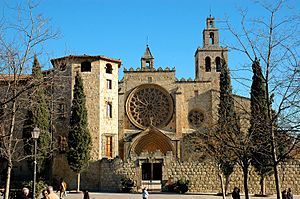Monastery of Sant Cugat facts for kids
The Monastery of Sant Cugat is a very old Benedictine church and building complex in Sant Cugat del Vallès, Catalonia, Spain. It was started in the 800s and was built over many centuries, until the 1300s. For a long time, it was the most important monastery in the area around Barcelona. Its most famous part is its large Romanesque cloister, which is a special open courtyard with covered walkways.
A Look at History: The Monastery's Story
The monastery's story began in the 800s. People decided to connect an old church, which held the remains of a saint named Cucuphas, with a nearby fort. From the 900s, the monastery started to get bigger and own more land. In the year 985, an army led by al-Mansur Ibn Abi Aamir attacked it, causing some damage. However, al-Mansur then helped fix it and added a tall tower called a minaret. This minaret is still the highest point of the monastery today.
Later, in the late 1000s, a ruler named Ramon Berenguer II of Barcelona decided that the monastery should be controlled by another monastery far away in France. This caused problems among the monks at Sant Cugat. The leader (abbot) from the French monastery moved in, and some monks who didn't agree with him were sent away. But the bishop of Barcelona said that he had rights over the monastery. So, the monastery was returned to the church leaders in Barcelona. At that time, Sant Cugat was in charge of several other monasteries nearby.
In the middle of the 1100s, workers began building a new monastery. It was finally finished in 1337. Around 1350, they started adding strong walls to protect the monastery. During a big war called the War of Spanish Succession, soldiers from Archduke Charles took over the monastery. This caused some damage to the buildings. But by 1789, all the repairs were done.
In 1835, the monks left the monastery, and it stayed empty for many years. In 1851, work began to restore it again. In 1931, it was officially named a National Monument, which means it's a very important historical building.
Amazing Architecture and Art
The most special part of the monastery is its cloister. This is a beautiful example of Romanesque art from the 1100s. In the 1500s, they added a second floor to the cloister, along with an entrance area.
The cloister is more than 30 meters long. It was designed by a person named Arnau Cadell and his student Lluís Samaranch. It has a square shape with rounded arches. These arches are held up by pairs of columns. Each of these columns has a wonderfully carved top part, called a capital. These carvings show all sorts of things, from animals to stories from the Bible.
Even though the cloister is Romanesque, the main church building is built in the Gothic style. It has a main area (called a nave) and two side areas (called aisles). The front of the church has a very large round window, about 8.2 meters wide, called a rose window. It looks similar to the beautiful rose windows in the Cathedrals of Barcelona and Tarragona. Inside the church, there is a Gothic altarpiece, which is a decorated screen behind the altar. It's called the retaule de Tots els Sants and was made in 1375 by an artist named Pere Serra.
See also
 In Spanish: Monasterio de San Cugat del Vallés para niños
In Spanish: Monasterio de San Cugat del Vallés para niños




